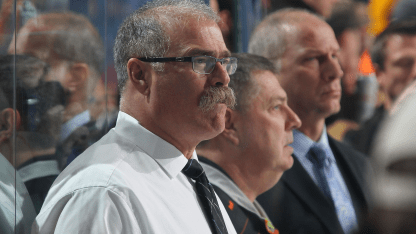The Coaches Room is a regular feature throughout the 2023-24 season by former NHL coaches and assistants who turn their critical gaze to the game and explain it through the lens of a teacher.
In this edition, Paul MacLean, former coach of the Ottawa Senators, who won the Jack Adams Award as NHL coach of the year in 2013, and assistant with the Anaheim Ducks, Detroit Red Wings, Columbus Blue Jackets and Toronto Maple Leafs, looks at how coaches deal with the looming NHL Trade Deadline (3 p.m. ET on March 8).
The Trade Deadline nowadays, the hype for it starts in November. The media has the countdown and who is on the trade-bait list seems like it comes out right after training camp. So, the drum gets beat all winter long now.
Back in the day, nobody worried about it until two days before the Deadline. Now it’s out there and it’s talked about all the time, and it should be -- it’s a significant event in the calendar and an important part of it. Of course, the speculation with all the players has to be a little bit daunting sometimes if your name is there every day.
I think everyone is used to it now and this is the way that it goes, and you just try to handle it every day and talk to your player and say, “Listen, you’re here today, I’ll tell you what I can tell you, but as long as you’re here, we want you to play and we want you to be important.”
As a coach of a team that’s in the playoffs, it’s pretty much looking at what do we need in the conversations with your manager and your assistant coaches. What do we need as a coaching staff that we feel is going to give us a lift-up? We’re going to be in the playoffs, we’re likely going to be playing this team or that team, what do we need, a second-line center, a top-four defenseman? Do we need a fourth-line guy, do we need a depth guy?
It’s about what you need, and you’re going over those aspects of your team every day and monitoring your team. You’ve gone through the whole season and know how your team wants to play, the identity your team has. Then it’s about identifying players that possibly could be available that are going to come in and increase that identity of your team and fit into that identity of your team that puts you over the top against other opponents that you anticipate playing.
If you’re in the middle group that’s on the bubble, you’re in that third spot and you’re battling for the wild card, you’re really looking for some help. You’re really looking for something dynamic that can put you over the top of the teams you’re trying to chase, you’re trying to climb over two or three teams.
Injuries are always a part of every team and at this time of year, injuries can be devastating, and how do we add to our depth to get us in there?
If you’re a team that is basically out of the playoffs, the GM is going to sacrifice players that have been a part of your team to make our team better down the road, and you’re all-in on that.
The hardest job at the Trade Deadline is the team that’s out; the teams that are in and are battling and have something to play for. The other ones that are out, that’s the hardest part. Everyone knows that players are going to move.
Lots of times, some of the ones that stay are the ones that wanted to move, and the ones that wanted to stay are moved and you try to sort through all that stuff. Of course, the rumor mill is bigger now in the National Hockey League that it’s ever been with the media coverage that’s there, so almost everybody on your team, if you’re out of the playoffs, is talked about being traded. So, as a coach, you have to manage those players and trying to keep their heads focused on the day. You’re still trying to build your program and need to really focus on your identity and need to keep working on this because you’re not good enough to be where we need to be, and so you have to work on these things.
At the same time, you try to make that enjoyable, try to make that fun, and it’s hard to do at that time of the year when players know they’re not going to be in the playoffs. It makes it a little hard. But the big thing for me at that time of year, if you’re going through that, is teaching. It’s a great opportunity to teach professionalism; this is what professional athletes do no matter what the situation is, the game’s on the schedule, we’re coming to play and we’re going to be hard to beat, and that’s the drum that you beat if you’re that coach because that’s what makes everybody professional. When things haven’t gone your way is when you still show up and still make sure you’re a hard team to play against.
Usually what happens most of the time on a team that’s out of the playoffs is a popular player that’s been around a long time is moved. I think a lot of the time when that happens, they’re happy for the player to have an opportunity to maybe chase the Stanley Cup, which is what everybody wants to do. That’s why everyone’s playing the game.
On those teams, it’s more like it’s a great opportunity and they’re happy for him. But on the team that’s already in the playoffs and is looking to make a mark, when you trade that popular player, that can have a profound impact depending on his status in the locker room and what his role was in the room.
It can be a really significant mistake trying to upgrade a group if that player that gets traded is someone that is a really important “glue guy;” I would call him “Elmer.” He’s the glue that kind of kept the room together and you have to make sure you know that and you’re not moving that guy. It’s hugely important for those teams that are already in there, and even for those teams that are on the bubble.
That’s a really important guy for your team, the one that keeps everyone together and keeps everybody understanding what’s going on with the team. So, you have to be careful in those situations.


















